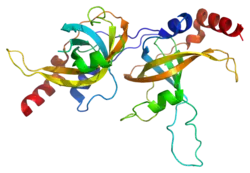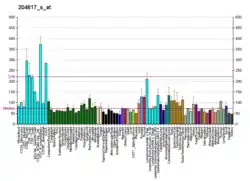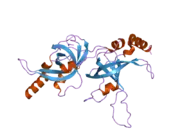ACD (gene)
Adrenocortical dysplasia protein homolog is a protein that in humans is encoded by the ACD gene.[5][6][7]
Function
This gene encodes a protein that is involved in telomere function. This protein is one of six core proteins in the telosome/shelterin telomeric complex, which functions to maintain telomere length and to protect telomere ends. Through its interaction with other components, this protein plays a key role in the assembly and stabilization of this complex, and it mediates the access of telomerase to the telomere. Multiple transcript variants encoding different isoforms have been found for this gene. This gene, which is also referred to as TPP1, is distinct from the unrelated TPP1 gene on chromosome 11, which encodes tripeptidyl-peptidase I.[7]
TPP1 is a component of the telomere-specific shelterin complex, which facilitates the replication of the double-stranded telomeric DNA tracts and protects the telomeric end from unregulated DNA repair activities. TPP1 mainly functions as a regulator of telomerase recruitment, activation, and regulation.[8] Although TPP1 was originally described as a bridging factor between TRF1 and TRF2, which participate in a pathway with POT1 as a negative regulator of telomerase-dependent telomere length control,[9] more recent studies suggest that TPP1 could directly promotes telomerase activity at the telomere.[10] A part of the TPP1 oligonucleotide/oligosaccharide-binding (OB) fold named TEL patch that interacts with the catalytic subunit of telomerase, hTERT, has been proven essential for telomerase activation.[11] TPP1 has also been demonstrated as the only pathway required for recruitment of telomerase to chromosome ends, and it also defines telomere length homeostasis in hESCs.[11]
References
- GRCh38: Ensembl release 89: ENSG00000102977 - Ensembl, May 2017
- GRCm38: Ensembl release 89: ENSMUSG00000038000 - Ensembl, May 2017
- "Human PubMed Reference:". National Center for Biotechnology Information, U.S. National Library of Medicine.
- "Mouse PubMed Reference:". National Center for Biotechnology Information, U.S. National Library of Medicine.
- Ye JZ, Hockemeyer D, Krutchinsky AN, Loayza D, Hooper SM, Chait BT, de Lange T (July 2004). "POT1-interacting protein PIP1: a telomere length regulator that recruits POT1 to the TIN2/TRF1 complex". Genes Dev. 18 (14): 1649–54. doi:10.1101/gad.1215404. PMC 478187. PMID 15231715.
- Liu D, Safari A, O'Connor MS, Chan DW, Laegeler A, Qin J, Songyang Z (July 2004). "PTOP interacts with POT1 and regulates its localization to telomeres". Nat Cell Biol. 6 (7): 673–80. doi:10.1038/ncb1142. PMID 15181449. S2CID 11543383.
- "Entrez Gene: ACD adrenocortical dysplasia homolog (mouse)".
- Karlseder J (September 2014). "Modern genome editing meets telomeres: the many functions of TPP1". Genes & Development. 28 (17): 1857–8. doi:10.1101/gad.250316.114. PMC 4197952. PMID 25184673.
- Hockemeyer D, Palm W, Else T, Daniels JP, Takai KK, Ye JZ, Keegan CE, de Lange T, Hammer GD (August 2007). "Telomere protection by mammalian Pot1 requires interaction with Tpp1". Nature Structural & Molecular Biology. 14 (8): 754–61. doi:10.1038/nsmb1270. PMID 17632522. S2CID 84294729.
- Nandakumar J, Bell CF, Weidenfeld I, Zaug AJ, Leinwand LA, Cech TR (December 2012). "The TEL patch of telomere protein TPP1 mediates telomerase recruitment and processivity". Nature. 492 (7428): 285–9. Bibcode:2012Natur.492..285N. doi:10.1038/nature11648. PMC 3521872. PMID 23103865.
- Sexton AN, Regalado SG, Lai CS, Cost GJ, O'Neil CM, Urnov FD, Gregory PD, Jaenisch R, Collins K, Hockemeyer D (September 2014). "Genetic and molecular identification of three human TPP1 functions in telomerase action: recruitment, activation, and homeostasis set point regulation". Genes & Development. 28 (17): 1885–99. doi:10.1101/gad.246819.114. PMC 4197946. PMID 25128433.
- Rual JF, Venkatesan K, Hao T, Hirozane-Kishikawa T, Dricot A, Li N, Berriz GF, Gibbons FD, Dreze M, Ayivi-Guedehoussou N, Klitgord N, Simon C, Boxem M, Milstein S, Rosenberg J, Goldberg DS, Zhang LV, Wong SL, Franklin G, Li S, Albala JS, Lim J, Fraughton C, Llamosas E, Cevik S, Bex C, Lamesch P, Sikorski RS, Vandenhaute J, Zoghbi HY, Smolyar A, Bosak S, Sequerra R, Doucette-Stamm L, Cusick ME, Hill DE, Roth FP, Vidal M (October 2005). "Towards a proteome-scale map of the human protein-protein interaction network". Nature. 437 (7062): 1173–8. Bibcode:2005Natur.437.1173R. doi:10.1038/nature04209. PMID 16189514. S2CID 4427026.
- Takai KK, Hooper S, Blackwood S, Gandhi R, de Lange T (January 2010). "In vivo stoichiometry of shelterin components". The Journal of Biological Chemistry. 285 (2): 1457–67. doi:10.1074/jbc.M109.038026. PMC 2801271. PMID 19864690.
- O'Connor MS, Safari A, Xin H, Liu D, Songyang Z (August 2006). "A critical role for TPP1 and TIN2 interaction in high-order telomeric complex assembly". Proceedings of the National Academy of Sciences of the United States of America. 103 (32): 11874–9. Bibcode:2006PNAS..10311874O. doi:10.1073/pnas.0605303103. PMC 1567669. PMID 16880378.
- Zaug AJ, Podell ER, Nandakumar J, Cech TR (March 2010). "Functional interaction between telomere protein TPP1 and telomerase". Genes & Development. 24 (6): 613–22. doi:10.1101/gad.1881810. PMC 2841338. PMID 20231318.
External links
- Human ACD genome location and ACD gene details page in the UCSC Genome Browser.
- Human TPP1 genome location and TPP1 gene details page in the UCSC Genome Browser.
- PDBe-KB provides an overview of all the structure information available in the PDB for Human Adrenocortical dysplasia protein homolog
Further reading
- de Lange T (2005). "Shelterin: the protein complex that shapes and safeguards human telomeres". Genes Dev. 19 (18): 2100–10. doi:10.1101/gad.1346005. PMID 16166375.
- Songyang Z, Liu D (2006). "Inside the mammalian telomere interactome: regulation and regulatory activities of telomeres". Crit. Rev. Eukaryot. Gene Expr. 16 (2): 103–18. doi:10.1615/critreveukargeneexpr.v16.i2.10. PMID 16749892.
- Cristofari G, Sikora K, Lingner J (2007). "Telomerase unplugged". ACS Chem. Biol. 2 (3): 155–8. doi:10.1021/cb700037c. PMID 17373762.
- Andersson B, Wentland MA, Ricafrente JY, Liu W, Gibbs RA (1996). "A "double adaptor" method for improved shotgun library construction". Anal. Biochem. 236 (1): 107–13. doi:10.1006/abio.1996.0138. PMID 8619474.
- Yu W, Andersson B, Worley KC, Muzny DM, Ding Y, Liu W, Ricafrente JY, Wentland MA, Lennon G, Gibbs RA (1997). "Large-scale concatenation cDNA sequencing". Genome Res. 7 (4): 353–8. doi:10.1101/gr.7.4.353. PMC 139146. PMID 9110174.
- Houghtaling BR, Cuttonaro L, Chang W, Smith S (2005). "A dynamic molecular link between the telomere length regulator TRF1 and the chromosome end protector TRF2". Curr. Biol. 14 (18): 1621–31. doi:10.1016/j.cub.2004.08.052. PMID 15380063. S2CID 19036934.
- Keegan CE, Hutz JE, Else T, Adamska M, Shah SP, Kent AE, Howes JM, Beamer WG, Hammer GD (2005). "Urogenital and caudal dysgenesis in adrenocortical dysplasia (acd) mice is caused by a splicing mutation in a novel telomeric regulator". Hum. Mol. Genet. 14 (1): 113–23. doi:10.1093/hmg/ddi011. PMID 15537664.
- Hutz JE, Krause AS, Achermann JC, Vilain E, Tauber M, Lecointre C, McCabe ER, Hammer GD, Keegan CE (2006). "IMAGe association and congenital adrenal hypoplasia: no disease-causing mutations found in the ACD gene". Mol. Genet. Metab. 88 (1): 66–70. doi:10.1016/j.ymgme.2006.01.006. PMID 16504561.
- Lim J, Hao T, Shaw C, Patel AJ, Szabó G, Rual JF, Fisk CJ, Li N, Smolyar A, Hill DE, Barabási AL, Vidal M, Zoghbi HY (2006). "A protein-protein interaction network for human inherited ataxias and disorders of Purkinje cell degeneration". Cell. 125 (4): 801–14. doi:10.1016/j.cell.2006.03.032. PMID 16713569. S2CID 13709685.
- O'Connor MS, Safari A, Xin H, Liu D, Songyang Z (2006). "A critical role for TPP1 and TIN2 interaction in high-order telomeric complex assembly". Proc. Natl. Acad. Sci. U.S.A. 103 (32): 11874–9. Bibcode:2006PNAS..10311874O. doi:10.1073/pnas.0605303103. PMC 1567669. PMID 16880378.
- Xin H, Liu D, Wan M, Safari A, Kim H, Sun W, O'Connor MS, Songyang Z (2007). "TPP1 is a homologue of ciliate TEBP-beta and interacts with POT1 to recruit telomerase". Nature. 445 (7127): 559–62. Bibcode:2007Natur.445..559X. doi:10.1038/nature05469. PMID 17237767. S2CID 4347362.
- Wang F, Podell ER, Zaug AJ, Yang Y, Baciu P, Cech TR, Lei M (2007). "The POT1-TPP1 telomere complex is a telomerase processivity factor" (PDF). Nature. 445 (7127): 506–10. Bibcode:2007Natur.445..506W. doi:10.1038/nature05454. hdl:2027.42/62923. PMID 17237768. S2CID 4383587.
- Wang F, Podell ER, Zaug AJ, Yang Y, Baciu P, Cech TR, Lei M (2007). "The POT1-TPP1 telomere complex is a telomerase processivity factor" (PDF). Nature. 445 (7127): 506–10. Bibcode:2007Natur.445..506W. doi:10.1038/nature05454. hdl:2027.42/62923. PMID 17237768. S2CID 4383587.






